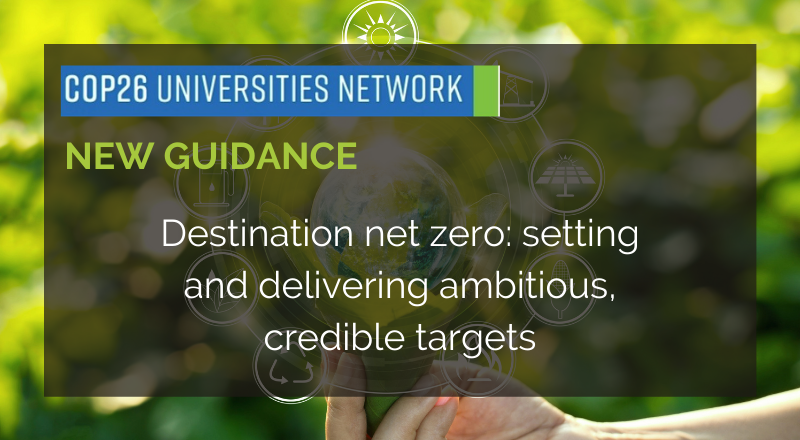This new briefing from the COP26 Universities Network sets out the science behind net zero targets and the considerations that policymakers and industry leaders should take when adopting and implementing such targets to represent the highest ambition in both planning and delivery.
Net zero emissions targets have gained traction in the global effort to halt climate change. This new briefing from the COP26 Universities Network sets out the science behind net zero targets and the considerations that policymakers and industry leaders should take when adopting and implementing such targets to represent the highest ambition in both planning and delivery.
Key messages
• Stabilising global temperatures at any level requires reaching net zero emissions. Stabilising at 1.5°C would mean reaching net zero global emissions of CO2 by mid-century and substantial reduction of other greenhouse gas emissions; the Paris Agreement also commits to a balance in human-caused sources and sinks of all greenhouse gases in the second half of the century.
• Net zero means balancing emissions (sources) with removals (sinks), which requires deep and widespread emissions cuts, as well as scaling up both nature-based and technological removal methods.
• Allied to net zero targets, immediate reductions of greenhouse gas emissions are essential, as global temperature rise is driven by cumulative carbon dioxide emissions over time. Reductions in emissions at source (as opposed to offsets and removals) should form the bulk of action to achieve net zero targets.
• Individual net zero targets and the pathways to achieve them should be driven by considerations of responsibility and capacity. To reflect their equity obligations under the Paris Agreement, industrialised nations should, as a matter of best practice, consider setting targets for delivering net zero before 2050.
• In order to be truly comprehensive, net zero targets should include all seven greenhouse gas groups reported under national inventories (while ensuring net zero CO2 specifically) and cover all economic sectors of activity.
• Plans should be specified for how an agreed net zero target will be delivered, and immediate policy action should be taken to put them on track. These plans should be published, as should regular updates on progress towards achieving them.
• An encouraging number of net zero targets are being set by national governments, regional, local and city governments, businesses, universities and third sector organisations. COP26 is an opportunity for more commitments to be made, and for ensuring targets are backed up by plans for delivery.
• Net zero targets and near-term actions to implement them can be expected to produce a range of benefits – as well as co-benefits – to those who adopt them.
You can access the complete COP26 Universities Network Briefing here.
Key messages
• Stabilising global temperatures at any level requires reaching net zero emissions. Stabilising at 1.5°C would mean reaching net zero global emissions of CO2 by mid-century and substantial reduction of other greenhouse gas emissions; the Paris Agreement also commits to a balance in human-caused sources and sinks of all greenhouse gases in the second half of the century.
• Net zero means balancing emissions (sources) with removals (sinks), which requires deep and widespread emissions cuts, as well as scaling up both nature-based and technological removal methods.
• Allied to net zero targets, immediate reductions of greenhouse gas emissions are essential, as global temperature rise is driven by cumulative carbon dioxide emissions over time. Reductions in emissions at source (as opposed to offsets and removals) should form the bulk of action to achieve net zero targets.
• Individual net zero targets and the pathways to achieve them should be driven by considerations of responsibility and capacity. To reflect their equity obligations under the Paris Agreement, industrialised nations should, as a matter of best practice, consider setting targets for delivering net zero before 2050.
• In order to be truly comprehensive, net zero targets should include all seven greenhouse gas groups reported under national inventories (while ensuring net zero CO2 specifically) and cover all economic sectors of activity.
• Plans should be specified for how an agreed net zero target will be delivered, and immediate policy action should be taken to put them on track. These plans should be published, as should regular updates on progress towards achieving them.
• An encouraging number of net zero targets are being set by national governments, regional, local and city governments, businesses, universities and third sector organisations. COP26 is an opportunity for more commitments to be made, and for ensuring targets are backed up by plans for delivery.
• Net zero targets and near-term actions to implement them can be expected to produce a range of benefits – as well as co-benefits – to those who adopt them.
You can access the complete COP26 Universities Network Briefing here.












